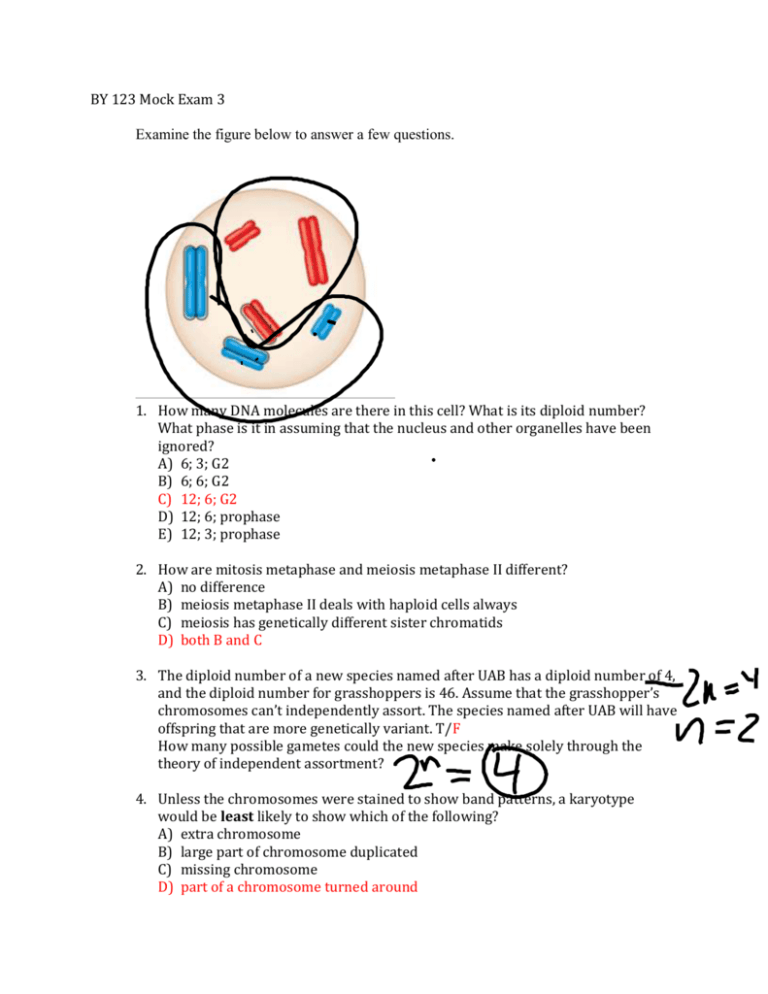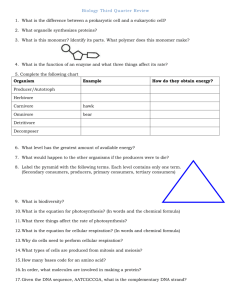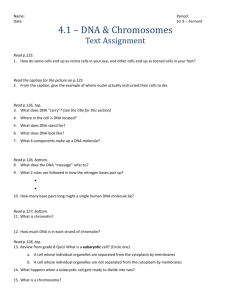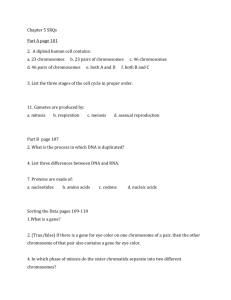BY 123 Mock Exam 3 Examine the figure below to answer a few
advertisement

BY 123 Mock Exam 3 Examine the figure below to answer a few questions. 1. How many DNA molecules are there in this cell? What is its diploid number? What phase is it in assuming that the nucleus and other organelles have been ignored? A) 6; 3; G2 B) 6; 6; G2 C) 12; 6; G2 D) 12; 6; prophase E) 12; 3; prophase 2. How are mitosis metaphase and meiosis metaphase II different? A) no difference B) meiosis metaphase II deals with haploid cells always C) meiosis has genetically different sister chromatids D) both B and C 3. The diploid number of a new species named after UAB has a diploid number of 4, and the diploid number for grasshoppers is 46. Assume that the grasshopper’s chromosomes can’t independently assort. The species named after UAB will have offspring that are more genetically variant. T/F How many possible gametes could the new species make solely through the theory of independent assortment? 4. Unless the chromosomes were stained to show band patterns, a karyotype would be least likely to show which of the following? A) extra chromosome B) large part of chromosome duplicated C) missing chromosome D) part of a chromosome turned around E) the attachment of a large part of a chromosome to another chromosome 5. In a diploid set of chromosomes, one member of each pair of homologous chromosomes is derived from the father (paternal), and the other comes from the mother (maternal). If 2n = 6, what is the probability of obtaining a gamete in which all the chromosomes are paternal ones? A) ¼ B) 1/8 C) 1/16 D) 1/32 E) answer can’t be determined 6. Which of the following occurs in meiosis, but not mitosis? A) cells have formed combination of genes as found in initial cell B) homologous chromosomes separate C) nuclear envelope disappears D) sister chromatids undergo disjunction E) spindle apparatus forms 7. At the end of telophase I of meiosis and the first cytokinesis, there are ____________. A) four haploid cells B) two diploid cells C) four diploid cells D) one haploid ovum and three polar bodies E) two haploid cells 8. The synaptonemal complex ________________. A) physically connect homologous chromosomes during prophase I. B) physically connects homologous chromosomes during mitosis C) is broken down by enzymes during anaphase II D) is another name for chiasmata E) is formed by a protein called cohesin 9. Sexual and asexual reproduction are alike in that _____. A) they both give rise to genetically distinct offspring B) they both involve two parents C) they both require meiosis to complete the reproductive cycle D) they can both occur in multicellular organisms E) in both cases, every parent transmits all of its genes to its progeny. 10. A plant with purple flowers is allowed to self-pollinate. Generation after generation, it produces purple flowers. This is an example of A) hybridization. B) incomplete dominance. C) true-breeding. D) the law of segregation. E) polygenetics. 11. What was the most significant conclusion that Gregor Mendel drew from his experiments with pea plants? A) There is considerable genetic variation in garden peas. B) Traits are inherited in discrete units, and are not the results of "blending." C) Recessive genes occur more frequently in the F1 than do dominant ones. D) Genes are composed of DNA. E) An organism that is homozygous for many recessive traits is at a disadvantage. 12. What is genetic cross between an individual showing a dominant phenotype (but of unknown genotype) and a homozygous recessive individual called? A) a self-cross B) a testcross C) a hybrid cross D) an F1 cross E) a dihybrid cross 13. How many unique gametes could be produced through independent assortment by an individual with the genotype AaBbCCDdEE? A) 4 B) 8 C) 16 D) 32 E) 64 14. Take the same genotype AaBbCCDdEE and cross it with AABBCCDDEE and determine the probability of getting offspring with AaBbCCDdEE. A) 0 B) can’t figure it out C) ¼ D) 1/8 E) 1/16 15. The fact that all seven of the pea plant traits studied by Mendel obeyed the principle of independent assortment means that A) none of the traits obeyed the law of segregation. B) the diploid number of chromosomes in the pea plants was 7. C) all of the genes controlling the traits were located on the same chromosome. D) all of the genes controlling the traits behaved as if they were on different chromosomes. E) the formation of gametes in plants occurs by mitosis only. 16. Blazer green (B) is dominant to gold (b). Dragon tails (T) are dominant to lizard tails (t). What fraction of the progeny of the cross BbTt × Bbtt will have blazer green and lizard tails? A) 1/16 B) 3/16 C) 3/8 D) 1/2 E) 9/16 17. In certain plants, tall is dominant to short. If a heterozygous plant is crossed with a homozygous tall plant, what is the probability that the offspring will be short? A) 1/2 B) 1/4 C) 0 D) 1 E) 1/6 18. A couple has three children, all of whom have brown eyes and blond hair. Both parents are homozygous for brown eyes (BB), but one is a blond (rr) and the other is a redhead (Rr). What is the probability that their next child will be a brown-eyed redhead boy? A) 1/16 B) 1/8 C) 1/4 D) 1/2 E) 1 19. A tall plant is crossed with a short plant, and the progeny are all intermediate in size between the two parental plants. This could be an example of A) incomplete dominance. B) polygenic inheritance. C) complete dominance. D) A and B E) B and C 20. Following a SsYy x SsYy cross, what percentage of the offspring are predicted to have a genotype that is heterozygous for both characteristics? a. 4/16 b. 2/16 c. 1/16 d. 3/16 21. Two heterozygotes (F1) were created which contain two independen tly‐assorting traits and interbred. Of their total of progeny obtained from a dihybrid cross which resemble their F1parents, which fraction will be true‐ breeding? a. 1/16 b. 1/8 c. 1/9 d. 3/16 e. ½ 22. You are attempting to create a true‐breeding variety of hamster which has dark pigments at the tips of the ears, face, and limbs. However, you’re having a hard time establishing reproducible results during the hot summer months. Your conclusion is that: a. The gene for your trait must be involved in an epistatic relationship with another b. The trait is influenced through a polygenic mechanism c. Environmental effects are influencing the activity of the allele’s protein d. Codominance of several genes cause disproportionate lethality in the desired offspring which die in the heat e. The parental lines are not true‐breeding 23.In dogs, black (B) is dominant to chestnut (b), and solid color (S) is domin ant to spotted (s). What are the genotypes of the parents in a mating that produced 3/8 black solid, 3/8 black spotted, 1/8 chestnut solid, 1/8 chestnut spotted puppies? (Hint: try to find the genotypes of the puppies first) a. BBSs x Bbss b. BbSs x Bbss c. BbSS x BbSs d. BbSS x bbSs e. Bbss x bbss 24.John and Elizabeth just had their first child, Tommy. Both John and Elizabet are brown eyed but baby Tommy is blue eyed. John and Elizabeth also have free earlobes but baby Tommy has attached earlobes. Knowing that brown eyes (B) are dominant to blue (b) and free earlobes (A) are dominant to attached earlobes (a), what is the probability that their next child will have blue eyes and free earlobes? a.1/16 b.9/16 c.¾ d.3/16 e.¼ 25.A woman with type O blood is expecting a child. Her husband is type A. Both the woman’s father and her husband’s father had type B blood. What is the probability that the child will have type O blood? a.0% b.25% c.50% d.75% e.It cannot be determined from the given information 26.A mother with type B blood has two children, one with type A blood and one with type O blood. Her husband has type O blood. Which of the following could you conclude from this information? a.The husband could not have fathered either child b.The husband could have fathered both children c.The husband must be the father of the child with type O blood and could be the father of the type A child d. Neither the mother nor the husband could be the biological parent of the type A child e.The husband could be the father of the child with type O blood, but not the type A child 27.In most mammals dosage compensation is achieved by random inactivation of one of the X chromosomes in the somatic cells of females. However, in the marsupials activation is non random, and it is the X chromosome that is inherited from the father (the paternal X) that is preferentially inactivated in all somatic cells of females. What are the consequences of this for x ‐linked traits in marsupials? a. Heterozygous females will not be somatic mosaics but will show one phenotype or the other b. Both male and female heterozygotes will be somatic mosaics c. Heterozygous females will not occur d. None of the above 28. What is the probability that a male will inherit an x‐linked recessive allele from his father? a.0% b.25% c.50% d.75% e.100% 29.In werewolves, pointy ears (P) are dominant over round ears (p). The gene is on the X chromosome. A certain female werewolf has pointy ears even though her father had round ears. What percentage of her sons will have round ears if she mates with a werewolf with round ears? a. 25% b. 50% c. 75% d. 0% e. 100% 30. A woman is red-green color blind. What can we conclude, if anything, about her father? a. He has two Y chromosomes b. He is red-green color blind c. There is a 50% probability that he has normal vision d. There is too little information to tell e. None of the above 31. A woman is a carrier for red‐green color blindness, a sex‐linked trait. Her husband is normal (not‐color blind) for this trait. What are the chances that their newborn daughter will be red‐green color blind? a.75% b.100% c.0% d.50% e.25% 32. Hemophilia is a sex‐linked disorder. The daughter of a father with hemophilia and a carrier mother has a ____ probability of having hemophilia a.0% b.100% c.33% d.25% e.50% 33. An affected male and a normal female have four children: two affected daughters and two normal sons. Each of the affected daughters (and their normal husbands) produced affected sons and affected daughters. The couple’s normal sons married normal women and had all normal children. What is the most likely mode of inheritance for this trait? a. Autosomal dominant b. Autosomal recessive c. Sex‐linked dominant d.Sex‐linked recessive e. It cannot be determined 34. How many Barr bodies would be observed in the nucleus of an XYY individual? a.1 b.2 c.3 d.0 35. With a microscope, you examine some somatic cells from a woman and notice that each nucleus has two Barr bodies. What can you infer about the sex chromosomes about the sex chromosomes in this individual? a. She is XX b. She is XXY but the Y chromosome lacks the SRY gene c. She is XXXX d. She is XXX e. None of the above 36. Gene A is normally found on chromosome number 15 in humans. If amniocentesis reveals fetal cells containing gene A on chromosome 17, but not 15, the best explanation would be that: a. Base substitution occurred either during gametogenesis or in the mitotic divisions following fertilization b. An inverstion of gene A occurred on chromosome 15 c. At least one parent probably had a genetic syndrome d. Translocation occurred e. Crossing over occurred during synapsis of meiosis I in one parent’s gametes 37. It is proposed that a certain disorder affecting the inner ear is caused by mitochondrial DNA. Which of the following observations would be the most decisive evidence against this idea? a. Fathers with the disorder pass it on to all their children, but mothers with the disorder do not pass it along b. Females and males have the disorder in equal numbers c. Mothers pass the disorder on to their offspring, but fathers do not d. The precise cause of the disorder is found to involve the nervous system e. All of the above would be evidence against mitochondrial inheritance of this condition 38. Because polymerization of nucleotides is an endergonic process, energy is required for it to occur DNA polymerase uses what as its energy source? a.ATP b.The nucleotides themselves c.Entropy created from protein digestion d.Both A and C e.Both B and C 39. A sample of DNA is composed of 14% Cytosine. How much Thymine is present in the sample? a. 28% b. 72% c. 30% d. 50% e. None of the above 40. E. coli cells grown on 15N medium are transferred to 14N medium and allowed to grow for two more generations (two rounds of DNA replication). DNA extracted from these cells is centrifuged. What density distribution of DNA would you expect in this experiment? A) one high-density and one low-density band B) one intermediate-density band C) one high-density and one intermediate-density band D) one low-density and one intermediate-density band E) one low-density band 41.DNA polymerase adds nucleotides to the ______ of the leading strands, the __ ___ of the lagging strands a. 5’ end... 3’ end b. 5’ end... 5’ end c. 3’ end... 5’ end d. 3’ end... 3’ end e. Sugar group... phosphate group 42.An organism has a disease in which they cannot produce the enzyme ligase What would be an effect of this disease? a. Replication of the leading strand could not occur b. Replication of the lagging strand could not occur c. Nucleotide excision repair could not occur d. Both A and C e. Both B and C 43.After formation of a replication bubble which of the following is the correct sequence of enzymes used for the synthesis of the lagging DNA strand? a. Helicases, primase, DNA polymerase, ligase b. Ligase, primase, DNA polymerases, helicases c. Primase, helicases, DNA polymerases, ligase d. Helicases, primase, ligase, DNA polymerases e. Helicases, DNA polymerases, primase, ligase 44. Which set of enzymes is involved in nucleotide excision repair? a. Nuclease, DNA polymerase, primase b. Ligase, nuclease, primase c. Hydrolase, nuclease, ligase d. Nuclease, DNA polymerase, ligase e. DNA polymerase, helicase primase 45. The complementary strand for 5’TACGCATTAG3’ is: a. 3’ ATGCGTAATC 5’ b. 5’ CTAATGCGTA 3’ c. 5’ AUGCGUAAUG 3’ d. 5’ CUAAUGCGUA 3’ e. None of the above 46. How many nucleotides are needed to code for a protein with 450 amino acids? a. At least 150 b. At least 300 c. At least 450 d. At least 900 e. At least 1,350 47.A strand of mRNA is complementary to the ________ strand and identical to t the __________ strand. a. Template, non template b. Non template, template c. Template, template d. None of the above 48. A strand of non‐template DNA reads 5’ CATAGC 3’ what are the corresponding codons on the mRNA strand? a. GTA, TCG b. CAU, AGC c. CAT, AGC d. GUA, UCG e. None of the above 49. Which of the following is needed to initiate transcription? I. RNA polymerase II. DNA polymerase III. Transcription factors IV. CAT box a. I, III, and IV b. II, III, and IV c. I and III only d. II and III only e. I, II, III, IV 50.T/F The strand of mRNA that is created through transcription is immediately taken to a ribosome for translation. 51. Which of the following statements is false? a. In bacteria, proteins called transcription factors enhance the affinity of RNA polymerase to the promoter sites of genes b. In bacteria, transcription of a gene is initiated when the RNA polymerase by itself recognizes and binds to the promoter of the gene c. The initiation of gene transcription in eukaryotes requires the binding of proteins called transcription factors to the TATA box in the promoter region of a gene d. A relaxation of chromatin packing in eukaryotic cells can facilitate the binding of transcription factors to a promoter of a gene e. All of the listed response are correct 52. Which of the following enzymes works after transcription but before translation? a. Spliceosome b. Ribozyme c. Ligase d. Both A and C e. Both B and C f. Both A and B 53.A cell biologist found that two different proteins with largely different structures were translated from two different mRNAs. These mRNAs, however, were transcribed from the same template within the cell nucleus. Which mechanism below could best account for this? a. Different systems of DNA unpacking could result in two different mRNAs b. A point mutation might have altered the gene c. Exons from the same gene could be spliced in different ways to make different mRNAs d. Different transcription factors were involved in the transcription of the two mRNAs e. The wobble hypothesis 54. Which of the following is not true of an anticodon? a. It consists of three nucleotides b. It lines up in the 5’ -> 3’ direction along the 5’ -> 3’ mRNA strand c. It extends from one loop of a tRNA molecule d. It may pair with more than one codon e. Its base uracil pairs with adenine 55. Place the following events in the synthesis of a polypeptide in the proper order I. A peptide bond forms II. An aminoacyl tRNA matches its anticodon to the codon in the A site III. A tRNA translocates from the A site to the P site, and an unattached tRNA exits from the E site IV. The large subunit attaches to the small subunit, with the initiator tRNA in the P site V. A small subunit binds to an mRNA and an initiator tRNA a.IV, V, III, II, I b.IV, V, II, I, III c.V, IV, III, II, I d.V, IV, I, II, III e.V, IV, II, I, III 56. A tRNA with the anticodon 3’ UGU 5’ could bind with the mRNA codon: a. 5’ ACA 3’ b. 5’ ACG 3’ c. 5’ CCA 3’ d. Both A and B e. Both B and C 57. How many aminoacyl tRNA synthetases are there? a. 46 b. 20 c. 1 d. 3 e. None of the above 58. The P site of a ribosome does which of the following? a. It holds the tRNA that is carrying the next amino acid to be added to the growing polypeptide chain b. It holds the tRNA carrying the growing peptide chain c. It helps unzip DNA during transcription d. It catalyzes the addition of amino acids to the tRNAs e. It recognizes the promoter during transcription initiation 59. First amino acid inserted into a new polypeptide chain for eukaryotic cells and prokaryotic? Non-sense codons? Methionine formyl-methionine UGA, UAG, UAA









